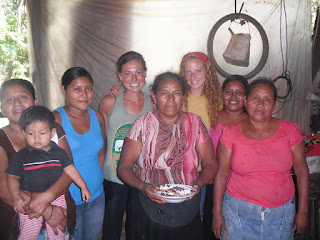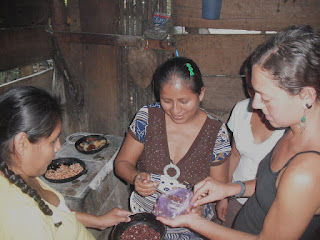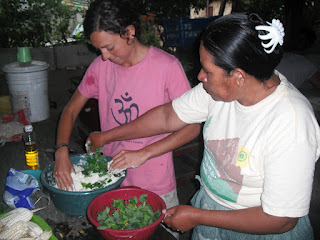The nutrition program at Semilla Nueva has been developing since I arrived in September. Unfortunately, Guatemala has one of the highest malnutrition rates in the world; knowing this is what first drew me to this country. My first task was to conduct a malnutrition study in some of the communities we work with on the coast. The work consisted of collecting data on food consumption, food accessibility, nutrition related illness, as well as, assessing the body composition of children.
So what do I, as a nutritionist, and Semilla Nueva do with this information? Should we teach them? Feed them? Introduce supplements? The source of food is often the first thing on my mind when examining nutrition status. Besides the land, the women of the households are the ones preparing the meals and feeding their families. Because of this, we decided to start working with women’s groups to discuss new ideas about food security, consumption, access, and nutrition. We are doing this primarily through meetings and workshops on health related topics, as well as introducing new recipes, cooking, and sharing meals with the women.

As I prepared for my first trip to a rural community, I couldn’t help but wonder if anyone would want to participate in the study at all. The community of Willywood proved me wrong, and I ended up taking the heights and weights of nearly 300 children. This lead to an analysis that revealed over 85% of children to be short for stature. This characteristic alone is often indicative of malnutrition. After countless interviews and survey questions, I found that these children are eating every day so they are not, in fact, “starving”.
However, because the Guatemalan diet consists primarily of tortillas and low amounts of black beans, they are certainly not getting a variety of foods with the nutritional requirements they need for normal growth and development. This puts these children at risk for cognitive impairments, physical disabilities, and infections leading to more serious illnesses.
 Because their husbands and sons have been working in the field with the rest of our Semilla Nueva team planting and harvesting pigeonp pea, we thought this would be a great starting point. The women expressed interest and enthusiasm in learning how to cook with this crop. So, using this bean as the base for introducing new recipes seemed like the best way to tackle the health situation. I became extremely excited to meet the needs of the communities through cooking and sharing meals.
Because their husbands and sons have been working in the field with the rest of our Semilla Nueva team planting and harvesting pigeonp pea, we thought this would be a great starting point. The women expressed interest and enthusiasm in learning how to cook with this crop. So, using this bean as the base for introducing new recipes seemed like the best way to tackle the health situation. I became extremely excited to meet the needs of the communities through cooking and sharing meals.
 We began our work in the community of Conrado de la Cruz. We were able to ask the women what they wanted to learn and combine that with our own goals, then collaboratively come up with a plan. We now have four groups of women who regularly attend our meetings and cooking sessions. Each group experiments with a new pigeon pea recipe, as well as other recipes like salads and atol (a warm beverage). As any woman can attest, time spent in the kitchen with other women is a life source. Time is spent laughing, sharing struggles, hopes, fears and most importantly talking about food! So far, we have heard enthusiastic requests for learning about the different food groups, distinguishing which foods have certain nutrients, and trying new foods like leche de gandule (pigeonpea milk). We are really honing in on the idea of community and sharing knowledge learned. So, we ask each group to share the recipes we have tried with the other women’s groups. Our hope is that they will pass them on to other women in the community, as well.
We began our work in the community of Conrado de la Cruz. We were able to ask the women what they wanted to learn and combine that with our own goals, then collaboratively come up with a plan. We now have four groups of women who regularly attend our meetings and cooking sessions. Each group experiments with a new pigeon pea recipe, as well as other recipes like salads and atol (a warm beverage). As any woman can attest, time spent in the kitchen with other women is a life source. Time is spent laughing, sharing struggles, hopes, fears and most importantly talking about food! So far, we have heard enthusiastic requests for learning about the different food groups, distinguishing which foods have certain nutrients, and trying new foods like leche de gandule (pigeonpea milk). We are really honing in on the idea of community and sharing knowledge learned. So, we ask each group to share the recipes we have tried with the other women’s groups. Our hope is that they will pass them on to other women in the community, as well.
 In the past few weeks we have been experimenting with some recipes in which pigeon peas are replacing black beans in traditional Guatemalan dishes such as tortillas and tostadas de gandule (a toasted tortilla with pureed pigeonpea). We have also been trying new dishes like soups and drinks where pigeonpea is still the focal ingredient, but we make sure to incorporate other highly nutritious foods like yerba mora (a swiss chard like leafy green, rich in vitamins and minerals). We want each food to be packed with nutrients and flavor. However, we also want to be respectful of their local customs and cognizant of their commonly used ingredients. Most of the time, the finished products have been widely accepted by the women, some along with promises of repetition. Others have been more a trial and error, which is, and should be, a part of all kitchen experiments.
In the past few weeks we have been experimenting with some recipes in which pigeon peas are replacing black beans in traditional Guatemalan dishes such as tortillas and tostadas de gandule (a toasted tortilla with pureed pigeonpea). We have also been trying new dishes like soups and drinks where pigeonpea is still the focal ingredient, but we make sure to incorporate other highly nutritious foods like yerba mora (a swiss chard like leafy green, rich in vitamins and minerals). We want each food to be packed with nutrients and flavor. However, we also want to be respectful of their local customs and cognizant of their commonly used ingredients. Most of the time, the finished products have been widely accepted by the women, some along with promises of repetition. Others have been more a trial and error, which is, and should be, a part of all kitchen experiments.

Day by day we are spending time sharing knowledge, skills, and meals with women that hopefully will last a lifetime.
No comments:
Post a Comment